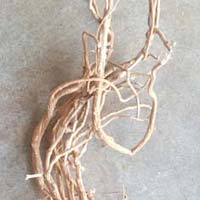
Punarnava Roots
90 Per Kilogram
50 Kilogram (MOQ)
Different Names : Assamese: Ranga Punarnabha Bengali: Rakta punarnava English: Hogweed, Pigweed, Spreading Hogweed Gujrati: Dholisaturdi, Motosatodo Hindi: Gadhapurana, Gadapurna, Lalpunarnava, Sant, Thikri, Beshakapore, Lal Punarnava Kannada: Komme gida, Sanadika, Kommeberu, Komma, Teglame, Ganajali Kashmiri: Vanjula Punarnava Malayalam: Thazhuthama, Thavizhama, Chuvanna Tazhutawa Marathi: Ghetuli, Vasuchimuli, Satodimula, Punarnava, Khaparkhuti Oriya: Lalapuiruni, Nalipuruni Punjabi: ltcit (Ial), Khattan Tamil: Karichcharanai, Mukaratte, Mukurattai, Mukkaraichchi Telugu: Atika mamidi, Atikamamidi, Erra galijeru Sinhalese: Pitasudupala, Pitasudu-sarana

Punarnava Roots
80 - 140 Per Kilogram
50 Kilogram (MOQ)
Scientific name: Boerhavia diffusa Sanskrit: Bhauma, Kathillaka, Krishnakhya, Krura, Lohita, Mandalpatrika, Nava, Navya, Nila, Nilapunarnava, Nilavarshabhu, Nilini, Pravrishenya, Punarbhava, Punarnava, Raktakanda, Raktapatrika, Raktapunarnava, Raktapushpa, Raktapushpika, Raktavarshabu, Sarini, Shilatika, Shonapatra, Shophagni, Shothagni, Shyma, Swatapunarnava, Vaishakhi, Varshabhava, Varshabhu, Varshaketu, Vikasvara, Vishaghni, Vishakarpara Malayalam: Thazhuthama, Thavizhama, Chuvanna Tazhutawa Marathi: Ghetuli, Vasuchimuli, Satodimula, Punarnava, Khaparkhuti Tamil: Karichcharanai, Mukaratte, Mukurattai, Mukkaraichchi Telugu: Atika mamidi, Atikamamidi, Erra galijeru Hindi: Gadhapurana, Gadapurna, Lalpunarnava, Sant, Thikri, Beshakapore, Lal Punarnava
Best Deals from Boerhaavia Diffusa

punarnava root
Get Price Quote
We are offering punarnava root. What is it? common name: spreading hogwood, punarnava botanical name: boerhavia diffusa parts used : root herbs are the 'medicinal plants' used in treating and curing ailments, as well as enhancing the wellbeing, vigour and vitality of an individual. Other than this, herbs have also been associated with providing seasoning, flavouring and essence to the food items. Today, herbs find immense usage in the field of medicine, food industry and also in the manufacturing of beauty products. The simple herbs that can be grown in the kitchen gardens find meritorious and handy use in treating day-to-day maladies. And particularly in recent years, herbs have found a lot of acceptance worldwide. This is because these are easy to use, safe with few if any side effects and are essentially an asset that puts our bodies in harmony with the nature. What is in it? ashwagandha is light and slimy by nature and hot in potency. The taste is a combination of sweet, bitter and pungent and the after taste is sweet. Chemical composition of the herb includes glycosides, acid, starch, sugars and amino acids. Other than these, approximately thirteen alkaloids like trophine, anapherine, anahygrine etc supplement the composition.